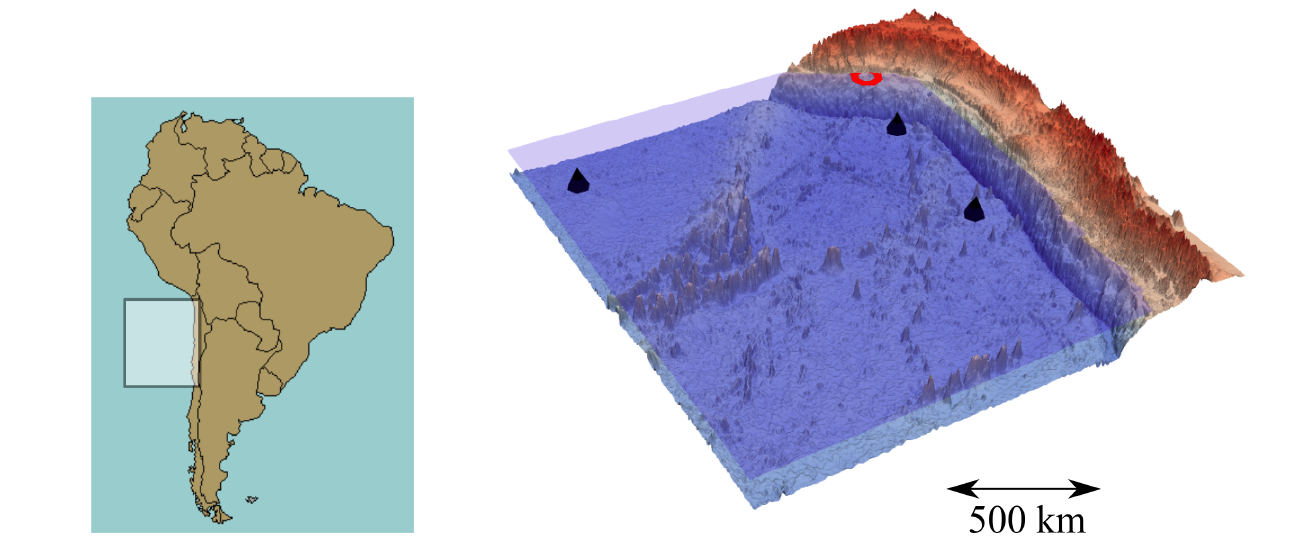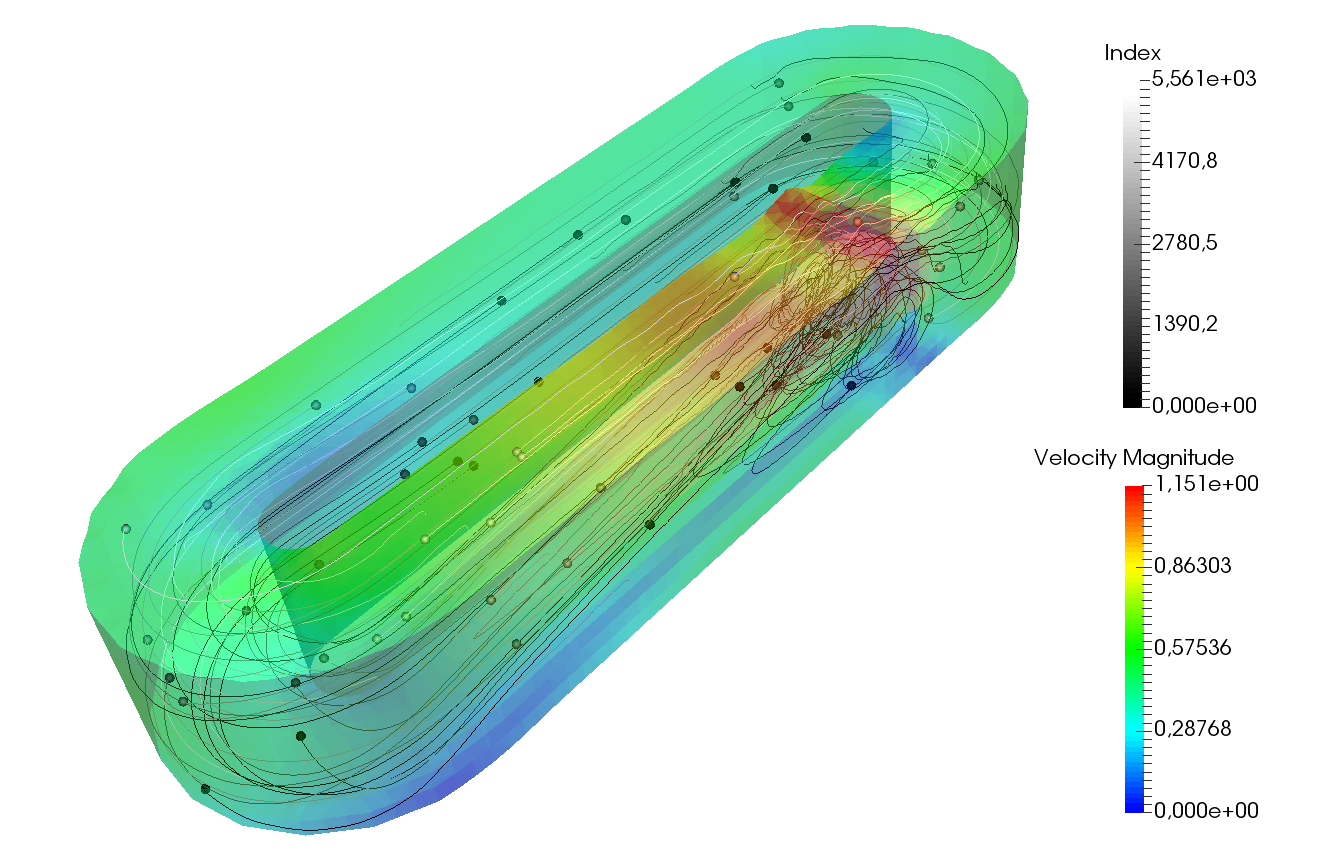Applications¶
Sustainable development and environment preservation have a growing importance and scientists have to address difficult issues such as management of water resources, resilience of society w.r.t. hazardous flows, renewable energy production, biogeochemistry of oceans.
Freshkiss3D proposes models of reduced complexity, suitable for scientific computing and endowed with stability properties (continuous and/or discrete) to help tackle these challenges. In this section we provide an overview of the research topics as well as some simulation examples that has been carried out with Freshkiss3D.

Examples of simulations carried out with Freshkiss3D¶
I - Hydrological disasters¶
Between 1996 and 2005, nearly 80% of natural disasters in the world have meteorological or hydrological origines. The main interest of their study is to predict the areas in which they may occur most probably and to prevent damages by means of suitable amenities. In France, floods are the most recurring natural disasters and produce the worst damages. For example, it can be a cause or a consequence of a dam break. The large surface they cover and the long period they can last require the use of reduced models like the shallow water equations. Tsunamis are another hydrological disaster largely studied. Even if the propagation of the wave is globally well described by the shallow water model in oceans, it is no longer the case close to the epicenter and in the coastal zone where the bathymetry leads to vertical accretions and produces substantial dispersive effects.
Tsunamis¶
Robust and accurate numerical methods have been worked out in order to simulate hazardous events involving water flows such as floodings or dam breaks. In particular, they have been applied to several tsunami cases such as the 2014 Iquique earthquake that struck off the coast of Chile on 1 April, with a moment magnitude of 8.1, at 20:46 local time. The epicenter of the earthquake was approximately 95km northwest of Iquique.

(Left) The Pacific ocean with the zone of interest; (Right) The chilean coast with the epicenter shown (red cone) and the location of the three DART buoys (black boxes)¶
Simulation has been carried out with a topography obtained from the National Oceanic and Atmospheric Administration (NOAA), an unstructured mesh whose dimensions a square of \(2224.2 km^2\) and a source (displacement of the seafloor due to the earthquake). Water height provided by numerical simulations turned out te be in good accordance with the records at each one of the 3 buoys.

Comparison between the sea level variations recorded by the DART buoys (after detiding using a low pass Butterworth filter of order 4 with a cuttoff frequency of 4 hours) and the simulation (\(1^{st}\) and \(2^{nd}\) order schemes). The simulation results have been filtered using the same Butterworth filter.¶
II - Hydrodynamics-biology coupled flows¶
Nowadays, simulations of the hydrodynamic regime of a river, a lake or an estuary, are not restricted to the determination of the water depth and the fluid velocity. They have to predict the distribution and evolution of external quantities such as pollutants, biological species or sediment concentration.
Algae growth in raceway ponds¶
The potential of micro-algae as a source of biofuel and as a technological solution for CO2 fixation is the subject of intense academic and industrial research. One of the key challenges in the production of micro-algae is to maximize algae growth with respect to the exogenous energy that must be used (paddlewheel, pumps, …). There is a large number of parameters that need to be optimized (characteristics of the biological species, raceway shape, stirring provided by the paddlewheel). To be able to predict algae growth, particle distance to the moving free surface is a the key factor to determine. Freshkiss3D Lagrangian particle tracking module allow to compute particles’ motion and thus predict particle path in raceway ponds. Several simulation results are shown below where a typical raceway containing algae, whose water is driven into motion by a paddlewheel. This work is carried out in collaboration with the Inria BIOCORE team.

Particles state after simulation start (left) and after several minutes of simulation (right).¶

Some particle path computation and velocity field¶
III - Geophysical flows¶
Reduced models like the shallow water equations are particularly well-adapted to the modelling of geophysical flows since there are characterized by large time or/and space scales. For long time simulations, the preservation of equilibria is essential as global solutions are a perturbation around them. The analysis and the numerical preservation of non-trivial equilibria, more precisely when the velocity does not vanish, are still a challenge.
The strait of gibraltar¶
Water fluxes through the strait of Gibraltar have been the subject of a lot of studies. It is a particularly interesting case as there is a two-way exchange happening through the strait. The upper layer which consists of fresh Atlantic water, enters Mediterranean see as the saltier lower layer is sucked up into the Atlantic ocean, due to his higher density. Variable density models implemented in Freshkiss3D allow accurate simulation of haline stratification processes.
Chlorides going up Vilaine river¶
Freshkiss3D allow to set-up real scale complex simulations that include multiple physical effects such as source terms, friction, wind, floodgate, sluice gate and floor drain boundary conditions. In a collaborative project with SAUR and IAV, all these aspects have been put together to predict density current induced chloride upstream propagation in the Vilaine river next to the Arzal dam and sliuce gate. With the opening of the floodgates a chloride mass source enters the domain and a density current going upstream develops. The large amount of data available thanks to IAV mesurements in the river allowed to validate variable density models included in Freshkiss3D on a real scale application. Some results of the simulations carried out with real input data during this project are presented below for several night/day cycle of the Arzal sliuce gate.

Salinity mesurments (dashed line) vs computation (full line) at different depth next to the the floor drain. Bottom figure shows floor drain flowrate as wall as floodgate chlorides mass source term.¶